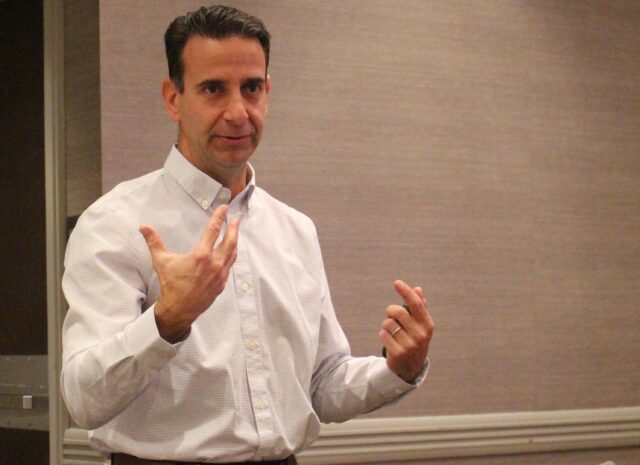WILMINGTON — Keeping up with technology is a challenge, but it is key in working with students, educators heard in early December in Wilmington.
Paul Sanfrancesco, the director of technology for the Owen J. Roberts School District in Chester County, Pa., spoke about the opportunities and challenges of social media for educators at “Leading in a New Era: Catholic Leadership Symposium” on Dec. 5 in Wilmington.
The symposium, which ran from Dec. 4-6, was hosted by the Diocese of Wilmington and Renaissance Learning, an educational resource organization. The symposium included presentations on several topics, including Sanfrancesco’s on “Cultivating Catholic digital footprints for students, parents, and religious educators.” Representatives from eight dioceses in Delaware, Pennsylvania and New Jersey were present.
Sanfrancesco told the group that there were lots of negatives about social media, but that the various platforms offered people a chance to feel like they are part of something.
“Community is about connections,” he said.
For students, social media affects the “four ‘Fs,’” Sanfrancesco said: faith, family, friends and future. Their digital presence is a huge part of their lives. The average 13-year-old, he continued, has 483 followers on Instagram and sees 50 stories a day on SnapChat. These apps are filling a role that should belong to parents.

“Our kids are getting influenced against the faith. Parents should be the No. 1 influencer” for their children, Sanfrancesco said.
He showed a screen full of icons for various social media, media, game and other applications that are popular with young people. None of the educators in the room could identify all of them. As he went through them, Sanfrancesco pointed out that the games have anonymous chat rooms where children can develop relationships with other players.
“We need to keep them informed on how to be safe,” he said. One way is to teach children not to reveal much in the way of personal information.
Sanfrancesco suggested parents keep an eye on their children’s online activity. On Instagram, for example, parents can log into multiple accounts and toggle between them on their own phones. It is important to explain that these posts last forever, even if they are deleted, and can affect them and others far into the future.
“Your family name is connected to every like, every post,” he said.
For educators, troublesome social media activity most often happens outside of school time, but the school must deal with the fallout. There is also the issue of unofficial pages set up, often on Facebook, by parents, alumni or others over which the school has no control. It is not all negative, Sanfrancesco said; there are parents who try to help and keep things positive.
Texting and FaceTime remain favorites for students, but some have turned to using Google Docs to communicate with friends because it is more difficult to track. Students often exchange messages through these online documents, then delete them. They often are recoverable, but not always.
The schools need to talk to their students about being able to correct situations and reporting issues to teachers.

“We need to teach these kids,” he said. “That’s being a digital Catholic citizen.”
Sanfrancesco noted that many schools confiscate phones from students who use them improperly during the day. He warned that schools never keep a phone at the end of the day.
“It’s like taking their keys,” he said.
Many parents use a phone’s GPS and video capabilities to monitor their children’s whereabouts. If a student’s phone does not register them as arriving home after school, the parent may worry that something has happened. Instead of keeping the phone, Sanfrancesco suggested contacting the parent and requiring them to come to the school to pick up the phone.
He also addressed the subject of teachers posting on social media. Students search for their teachers online all the time, so educators need to be careful about what they post, even on their own private pages. Many teachers in Catholic schools have a morals clause in their state teaching certificate, and an inappropriate post could cost them their job, even if everything is legal.
So, what are schools to do? Sanfrancesco said they should hold training for parents, making it mandatory if necessary. He suggested having students show the parents how to use the various applications, even making such training a way to earn service hours. The schools should also give students training in the responsible use of technology.
Showcase the good aspects of technology, he continued, and have parents and schools bring the Catholic faith into their children’s social media lives.
“When you bring the faith into it, they will listen,” he said.
Pope Francis has a prayer app, Click 2 Pray, and it can be installed as easily as SnapChat. Put the app’s icon right next to the ones the kids use the most and perhaps they will be tempted to click on it, even at least occasionally.
“Our kids have to know that they can always pray, and it has to be present on their phones,” Sanfrancesco said.







